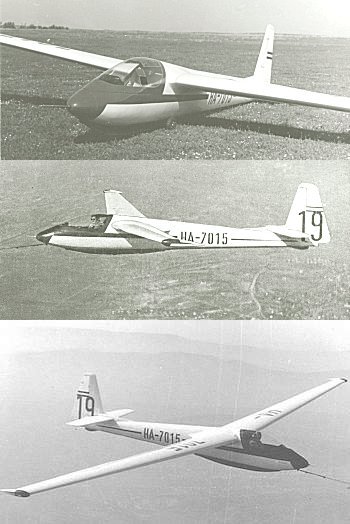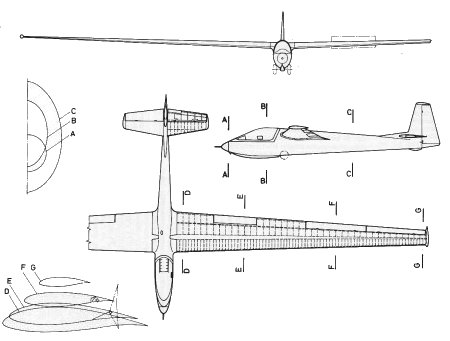HUNGARIAN
GLIDERS
1933-2000
| Type designation: |
A-08 |
| Name: |
Sirály I |
| Designer: |
Ferenc ZSEBŐ and his team: János CSERKUTI, Jenő OROSZ, Béla SAMU, József TÓTH, Gábor JEREB, Géza GARAMI and János VÁGHEGYI |
| Class: |
Performance |
| General arrangement: |
Cantilever, shoulder wing, traditional tail unit, tail-shute, nose and tail skid with dolly for launchings. |
| Crew: |
1 |
| First flight: |
May, 1956 |
| Manufacturer: |
Central Workshop of the Hungarian Aeronautical Association, Dunakeszi |
| Number of built: |
2 |

Short history:
A high performance glider to compete at the 1956 World Gliding Championships was ordered by MÖHOSZ, the central organization controlling all flying sports in Hungary, from the Central Aircraft Repair Workshop, Dunakeszi. The designers' goal was to create a glider with a maximum L/D of not less than 33, and a sinking speed of not more than 2,0 m/s at 140 km/h gliding speed.
The glider was designed as a conventional all-wooden structure due to the very tight time schedule. Flaps were not fitted as pilots had previously reported unfavorable experiences with flaps. The glider was certified for basic aerobatics.
Two gliders were completed just before the beginning of the World Championships. The gliders first flew at May of 1956. The pilots had practically no experience with the gliders before the Championships, where they felt the disadvantage caused by the absence of the flaps and the ineffectiveness of the airbrake.
The most important flights of the type are the following:
1956: 382 km distance (L. Kalmár); 63 km/h speed over 200 km triangle course, Hungarian record (Gy. Mező). 1959: 430 km distance (F. Csonka).
.jpg)
Structure: All wooden
Wing:
The wings of the shoulder-wing glider were tapered. The wingtips had "salmon" shaped fairings. The Frise type ailerons were splitted spanwise. The airbrakes were of trailing edge types, however after the first test flights a tail-chute of 1,6 m diameter was fitted due to the ineffectiveness of the airbrake. To haul in the chute was not possible in flight. There were no flaps on the wings, however a ballast tank of 60 l was fitted.
The wing had one I form wooden main spar, however at the outer part of the wing the web was made of duraluminium and was glued to the wooden booms. The wings were connected to each other and to the fuselage by longitudinal pins. The airfoil used was NACA 64318 and no aerodynamic washout was applied. To get a smooth surface on the wings an unusual dense rib structure were used with double plywood covering.
Fuselage:
The cross-section of the plywood covered semi-monocoque fuselage was elliptic, however behind the pilot's seat the fuselage had conical shape. In the comfortable cockpit a reclined seat was fitted. The one-piece bubble canopy was removable. The landing gear consisted of a well-faired nose and a tail skid. For launches a small double wheel dolly was used.
Tail unit:
The traditionally arranged tail surfaces had tapered plan-forms. All controls were mass-balanced.
.jpg)

| Dimensions: |
| Wing: |
| Span, m: |
17,6 |
| Area, m2: |
16,2 |
| Aspect ratio: |
19,2 |
| Chord (root), m: |
1,32 |
| Chord (tip), m: |
0,48 |
| Airfoil (root), m: |
NACA 64(3)-618 |
| Airfoil (mid-span), m: |
NACA 64(3)-618 |
| Airfoil (tip), m: |
NACA 64(3)-618 |
| Dihedral, degree: |
2,5 |
| Sweep, degree: |
0 |
| Washout: |
-1,5 geometric |
| Aileron: |
| Span, m: |
4,0 |
| Mean chord, m: |
0,175 |
| Total area, m2: |
1,4 |
| Balancing: |
Mass |
| Flap: |
| Type: |
None |
| Airbrakes: |
| Type: |
Trailing edge |
| Position (upside/downside): |
u/d |
| Total area, m2: |
1,05 |
| Position, % of chord: |
Trailing edge |
| Horizontal stabilizer: |
| Span, m: |
2,9 |
| Area, m2: |
1,75 |
| Elevator: |
| Span, m: |
2,9 |
| Area, m2: |
-0,8 |
| Airfoil: |
NACA 64-009 |
| Balancing: |
Mass |
| Trim: |
Yes |
| Vertical stabilizer and rudder: |
| Total area, m2: |
1,73 |
| Rudder area, m2: |
0,75 |
| Balancing: |
None |
| Fuselage: |
| Length, m: |
7,6 |
| Width, m: |
0,6 |
| Height: |
0,98 |
| Cross section, m2: |
0,52 |
| Landing gear: |
| Type: |
Nose and tail skids, double-wheel dolly |
| Wheel diameter, m: |
2 x 0,290 |
| Masses: |
| Wing, kg: |
? |
| Fuselage, kg: |
? |
| Tail unit, kg: |
? |
| Empty glider, kg: |
280 |
| Gross, kg: |
430 |
| Ballast, kg: |
60 |
| Wing loading, kg/m2: |
26,6 |
| Speeds: |
| VNE, km/h: |
250 |
| Max. speed with open airbrakes, km/h: |
180 |
| Max. aerotow speed, km/h: |
150 |
| Max. winch speed, km/h: |
120 |
| Max. speed in rough air, km/h: |
150 |
| Stall speed, km/h: |
68 |
| Performance: |
| Min. sink, m/s (at gliding speed, km/h): |
0,68/80 |
| Best L/D (at gliding speed, km/h): |
33,3/86 |
| Start methods: |
Winch, Aerotow |

Origin of data and 3-view drawing:
Jereb Gábor: Magyar vitorlázó repülőgépek, Műszaki Könyvkiadó, 1988, Budapest
(Gábor JEREB: Hungarian Gliders, Technical Publishing House, 1988, Budapest)
Gábor FEKECS E-mail: fekecs.gabor@t-online.hu

.jpg)
.jpg)
